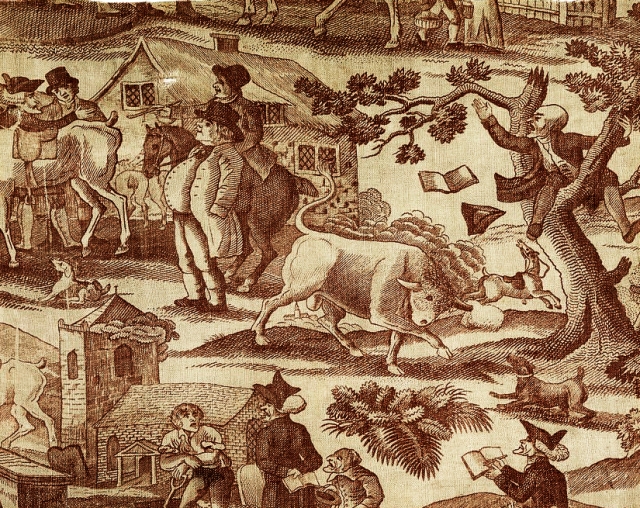
The ‘new’ agriculture required capital in ways that were unexpected. Capital to buy better livestock to improve your own. Capital to purchase marl and lime to add to the fertility of your land. Capital to bring marginal land into full production and capital to buy machinery, if you were in the forefront of progress. Sending your crops for sale in the most profitable markets also took the money to pay for transportation in advance of getting paid for the sale itself. You might also wish to take on more land, if it was available, since the cost of farming it might be only a little more than your current costs, while the value of the produce would be much greater.
The problem with subsistence farming is that it rarely produces a surplus for sale in the market. Why should it? If you can feed your own family, why struggle to produce more? And while subsistence farming demands little or no capital in itself, it generates none either. The great landowners — and almost all the land was in their ownership — might possess huge acreages, but the income in rent had often proved meagre at best. Enclosing the land, carving out separate farms of a sensible size and letting them to tenants with capital of their own to invest made good sense. It also allowed the landowner to charge higher rents. Even so, living from land ownership was never especially profitable. Like the crops themselves, rental income was at the mercy of fluctuating markets, uncertain weather and the efforts of the tenants themselves. In tough times, unpaid rents undermined the income from land ownership. Those landowners who grew rich from their ancestral acres were the ones who mined the mineral wealth from under the soil, not the crops on the surface.
Who wanted to do day labour anyway?
Many, many people. The countryside was awash with poor labourers trying to scratch a living, women eager for whatever work they could do and children sent out as young as four or five to bring home a few pence from scaring birds off the crops. To survive on day labour took a family effort. If there was no work locally, families took to the roads to seek out work elsewhere, despite the dangers of being judged ‘vagrants’ and punished accordingly. Strangers seeking work could expect no welcome. The local poor needed no competition to depress wages even further. The wealthy were determined not to pay higher Poor Rates to support families who were not even local.
Yet still they came. Demand for farm labour might be seasonal and erratic, but it was predictable on a larger scale. Harvesting, hop picking and threshing took place at roughly the same time each year. Knowing this, hoards of families descended on the areas most likely to offer work in the fields. Welsh women walked to Kent for the hop-picking. Irish labourers poured into England at harvest time. Most were so desperate they would work for starvation wages, thus ensuring wages were driven down for everyone.
Leaving the Land
Was it any wonder so many families headed for the new urban manufacturing centres? Living and working conditions might be no better — they might well be worse — but at least the work was regular.
Did nobody care about the plight of the poor, whether rural or urban? Very few. I’ve already mentioned the general belief that poverty was your own fault for not working harder and living more frugally. A large pool of labour was also deemed necessary to hold wages down. Clear-eyed people, like the influential writer Arthur Young in the 1780s, pointed out that even the poor would not work the hours they did, nor endure the appalling conditions and dangers, if dire necessity did not make them do so.
People then did the work machines do now, and were treated in the same way. You don’t feel compassion for a machine which operates 24 hours a day. You want to get the greatest amount of output possible for what it is costing you to run it. That’s how most Georgian capitalists felt about their workers.
Times, however, were changing. By the end of the century, social reformers and those with a strong religious outlook were already questioning the prevailing attitudes. Some built model workers’ housing in the belief that happier, healthier employees would be more productive and reliable. Others noted the working hours lost to alcohol — the cheapest way to numb the pain of poverty — and reasoned that paying higher wages and providing basic social care would pay off in terms of reduced absences and less down-time caused by accidents.
On the land, changes came more slowly. The introduction of machinery increased the demand for skilled workers, but caused a far greater loss in unskilled jobs. Poverty remained widespread, diffuse and easily overlooked. Romantics, like Oliver Goldsmith writing ‘The Deserted Village’, too easily looked back to a golden age of happy, healthy peasants; an age which never was. Working on the land, as opposed to owning and exploiting it, never produced better than a meagre subsistence. If it had, the ploughs and the seed drills would have been taken over by the rich long before.



Thank you for another interesting post. I admire your ability to present information and opinions in such a straightforward and therefore clear manner. I look forward to the next one!
LikeLiked by 1 person
Thank you kindly!
LikeLiked by 1 person